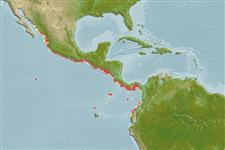Elasmobranchii (Haie und Rochen) (sharks and rays) >
Myliobatiformes (Stingrays) >
Urotrygonidae (American round stingrays)
Etymology: Urotrygon: Greek, oura = tail + Greek, trygon = a sting ray (Ref. 45335).
More on authors: Jordan & Starks.
Environment: milieu / climate zone / depth range / distribution range
Ökologie
seewasser demersal; tiefenbereich 2 - 30 m (Ref. 96339). Tropical; 27°N - 2°S, 110°W - 77°W
Eastern Central Pacific: southern Gulf of California to Ecuador.
Length at first maturity / Size / Gewicht / Alter
Maturity: Lm 11.8, range 11 - 13.5 cm
Max length : 46.2 cm TL Männchen/unbestimmt; (Ref. 9265); common length : 37.5 cm TL Männchen/unbestimmt; (Ref. 9265)
Found on soft bottoms of coastal waters (Ref. 9265). Feeds on crustaceans and small fishes (Ref. 37955). Venomous spine on tail (Ref. 9265). Sometimes utilized as a food fish (Ref. 37955).
Life cycle and mating behavior
Maturities | Fortpflanzung | Spawnings | Egg(s) | Fecundities | Larven
McEachran, J.D., 1995. Urolophidae. Rayas redondas. p. 786-792. In W. Fischer, F. Krupp, W. Schneider, C. Sommer, K.E. Carpenter and V. Niem (eds.) Guia FAO para Identification de Especies para lo Fines de la Pesca. Pacifico Centro-Oriental. 3 Vols. FAO, Rome. (Ref. 9265)
IUCN Rote Liste Status (Ref. 130435)
Nutzung durch Menschen
Tools
Zusatzinformationen
Download XML
Internet Quellen
Estimates based on models
Preferred temperature (Ref.
123201): 25.9 - 29.1, mean 28.3 °C (based on 118 cells).
Phylogenetic diversity index (Ref.
82804): PD
50 = 0.5001 [Uniqueness, from 0.5 = low to 2.0 = high].
Bayesian length-weight: a=0.01413 (0.00575 - 0.03468), b=3.07 (2.86 - 3.28), in cm total length, based on LWR estimates for this (Sub)family-body shape (Ref.
93245).
Trophic level (Ref.
69278): 3.9 ±0.63 se; based on food items.
Widerstandsfähigkeit (Ref.
120179): niedrig, Verdopplung der Population dauert 4,5 - 14 Jahre. (Assuming fecundity<100).
Fishing Vulnerability (Ref.
59153): Moderate vulnerability (36 of 100).
